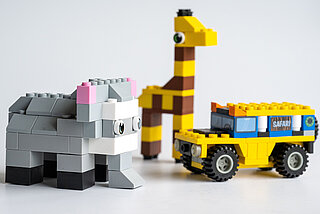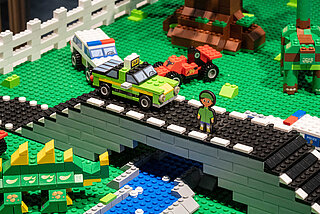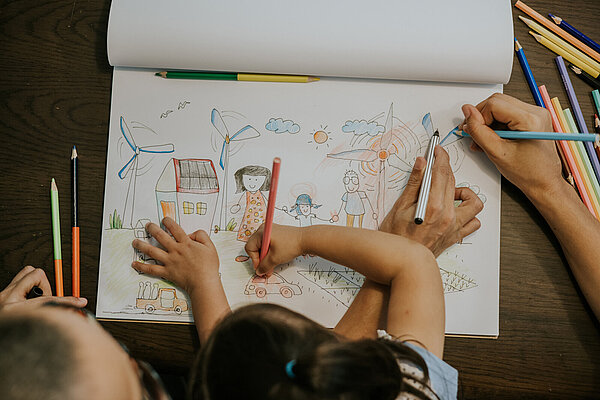
Colorful stones turn green
By Peter Thomas
Numerous toy manufacturers are planning to switch from petroleum-based plastics to materials made from natural raw materials. The young brand Biobuddi from the Netherlands is already showing how this transformation can succeed: Clamp building blocks and other toys are created CO2-neutrally from "green" polyethylene.
From turtles to fire engines: the clamp building block models from Dutch manufacturer Biobuddi take up classic themes from the world of building blocks for children. And thanks to intuitive construction beyond the instruction sheets, the nub bricks open up many other play worlds anyway. The material the bricks are made of, however, differs from the usual blocks: "Our building bricks are made exclusively of green polyethylene (bio-PE). This is a bioplastic obtained from a by-product of sugar cane processing," explains Managing Director Job Nijssen.

Most plastic toys are currently still produced from petroleum-based raw materials. This corresponds to the status in almost all industries, from the packaging industry to the household products sector. According to a presentation by the "European Bioplastics" association, bio-based materials today account for only about 1 percent of global plastics production. But that is likely to change in the coming years. In the toy industry, too, the search for alternatives to plastics made from fossil raw materials is in full swing. Clamp block market leader Lego, for example, added its first components made from bio-based polyethylene to its range in 2018 and is gradually expanding its offering. Mattel, with brands such as Fisher-Price, is also focusing on the medium-term transformation to plant-based plastics.
New start with new materials
Biobuddi was able to completely avoid such a change in its current business. This is because the Dutch start-up has been manufacturing its building blocks and other components from plant-based plastic right from the start. Important for the founders around Steve van Bommel: The green PE used can be completely recycled.
Our bricks are carbon dioxide neutral throughout the entire usage cycle.
Job Nijssen
This recyclability was not always a given for plastic products: as recently as 2022, Swedish researchers discovered that substances such as phthalates and chlorinated kerosenes are present in critical quantities in many very old plastic toys. This makes safe recycling of such products extremely difficult.

Biobuddi pays attention to sustainability not only in the raw material of the building blocks. Among other things, environmentally friendly paper packaging for the building sets also contributes to this, explains the managing director. In German toy stores, the sets of the "Small Blocks" series presented at Spielwarenmesse 2023 are available at prices ranging from 10 to 50 euros.
In the second half of the 2010s, Biobuddi started selling its building sets in the Netherlands. The blocks are produced locally using an injection molding process. The young company sources the granules of green PE from Germany. The product range includes small and large terminal building blocks as well as educational building sets and dominoes for the popular chain reaction sculptures.
Great opportunities for the future
In the future, plastics from sustainable sources will have an increasing role for the toy industry and other sectors. Many products are chemically equivalent to familiar plastics from fossil sources - for example, green polyethylene (bio-PE), green polyethylene terephthalate (bio-PET) and green polypropylene (bio-PP). In addition, there are new materials that have only become available for industrial plastics technology through the use of renewable natural raw materials. This group includes polylactic acid (PLA), polyhydroxyalkanoates (PHA) and thermoplastic starch (TPS).
In some cases, mixtures of conventional plastics and new materials (so-called blends) are also used. For example, a bioplastic has been developed at Chemnitz University of Technology that consists of two-thirds PLA, which is obtained from corn. The Franconian toy manufacturer Martin Fuchs uses it to produce sandbox toys, among other things. The Austrian research institute ACIB in Graz is also working on blends for use in the toy industry, for example a mixture of bio-PET and natural rubber.
The many approaches speak to a great dynamic of change. Ultimately, however, they all lead in a common direction: to play fun with safe, long-lasting products made from sustainable plastics.
About the author:
Telling stories about technology and people: This has fascinated the journalist, author, cultural scientist and lecturer for more than 30 years. Technical toys are always in focus, from construction kits to interactive digital educational toys. After studying and working as a research assistant at university, Peter Thomas writes for daily newspapers, magazines and corporate publications in German and English-speaking countries. In addition to the world of games, his focus is on mobility, security, energy and medical technology.




